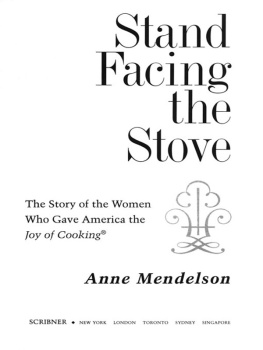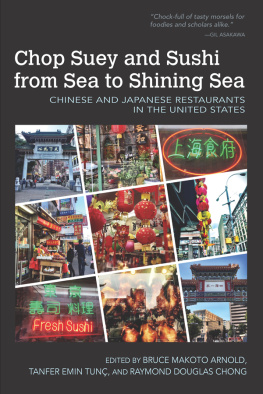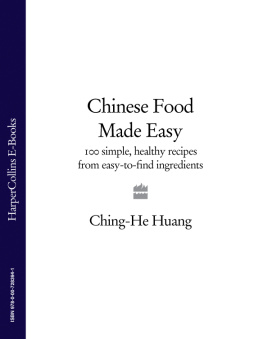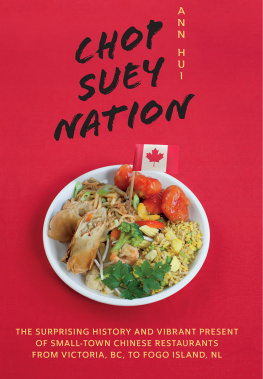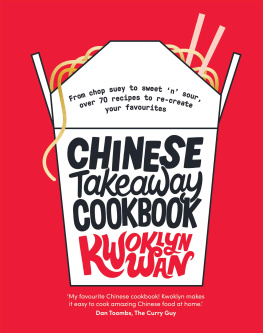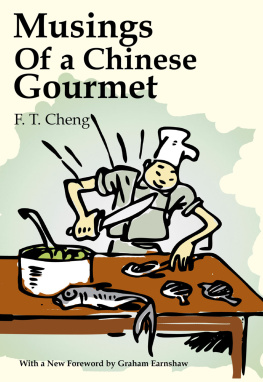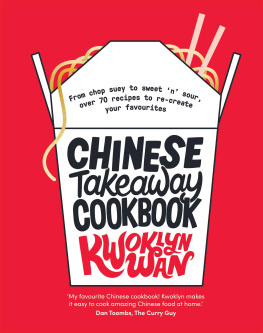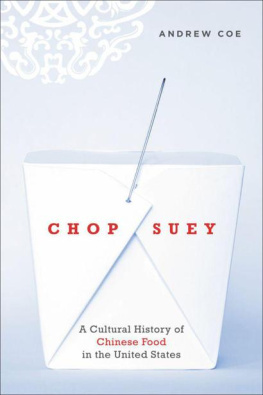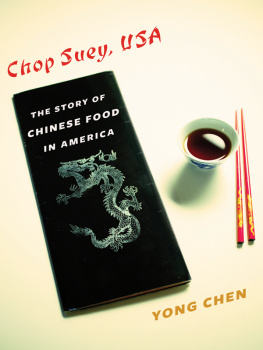Chow Chop Suey
Arts and Traditions of the Table: Perspectives on Culinary History
Albert Sonnenfeld, Series Editor
For a full list of titles in this series, see .
Chow Chop Suey
Food and the Chinese American Journey
Anne Mendelson

Columbia University Press
New York
Columbia University Press
Publishers Since 1893
New York Chichester, West Sussex
cup.columbia.edu
Copyright 2016 Anne Mendelson
All rights reserved
Library of Congress Cataloging-in-Publication Data
Names: Mendelson, Anne, author.
Title: Chow chop suey : food and the Chinese American journey / Anne Mendelson.
Description: New York : Columbia University Press, [2016] | Series: Arts and traditions of the table : perspectives on culinary history | Includes bibliographical references and index.
Identifiers: LCCN 2016020958 | ISBN 9780231158602 (cloth : alk. paper) | ISBN 9780231541299 (e-book)
Subjects: LCSH: Cooking, ChineseHistory. | Chinese AmericansFoodHistory. | Food habitsUnites States. | Emigration and immigrationUnited StatesHistory. | Chinese American familiesHistory.
Classification: LCC TX724.5.C5 M376 2016 | DDC 641.5951dc23
LC record available at https://lccn.loc.gov/2016020958
A Columbia University Press E-book.
CUP would be pleased to hear about your reading experience with this e-book at cup-ebook@columbia.edu.
COVER DESIGN: Jason Heuer
COVER IMAGE: Everett Historical/Shutterstock; Symbols: lightmood/Shutterstock
In loving memory of my husband,
Martin Iger,
who taught me to love Chinese food.
(Pronounced chau tsap sui in Cantonese, chao za sui in Mandarin)
Stir-fried () jumbled () fragments (), a phrase garbled by late-nineteenth-century English-speaking patrons of Chinese restaurants into chop suey, with the crucial word chau or chao omitted.
Contents
The number of people who helped in my research is beyond counting. Let me begin with the four members of the Coe-Ziegelman family. Andrew Coes seminal work Chop Suey: A Cultural History of Chinese Food in the United States inspired my own hope of some day writing about this subject, and he has offered encouragement at every step of the way. Jane Ziegelman had something penetrating to contribute whenever Chinese food was being discussed. I must thank their children, Buster and Edward, for being cheerful and intelligent participants in many talk-filled lunches in Flushing, Manhattan Chinatown, and elsewhere. Among the many friends who over the last few years shared in the eating, talking, and thinking, special thanks to Michael Gray and Patricia A. Andrews, Kian Lam Kho and Warren Livesley, Regina Schrambling and Bob Sacha, Danielle Gustafson and Bradley Klein, Cara De Silva, Madeleine Lim, and Ame Gilbert.
Many other writers and scholars generously shared ideas and information with me. I am especially indebted to Lucey Bowen, Ava Chin, Karen Christensen, Janet Chrzan, Fuchsia Dunlop, Nathalie Dupree, Jonathan Gold and Laurie Ochoa, Bruce Kraig, Rachel Laudan, Elizabeth L. Mo, Alejandro and Maricel Presilla, Jacqueline M. Newman, Molly ONeill, Erica J. Peters, Valerie Saint Rossy, Ed Schoenfeld, Scott Seligman, Richard Tan, Grace Young, and Willa Zhen.
My left-hand man, neurologist Dr. Gary Alweiss, kept this writers-cramp-afflicted southpaw more or less able to hold a pen throughout the writing process. Thanks, Gary!
I am grateful for moral support from my nephew Jorj Bauer and his wife, Susan Talbutt. Jorjs expertise also got me through several computer emergencies.
Thanks to Susan B. Carter for allowing me to cite important findings from her own forthcoming book on the Chinese in America, and to Zanne Stewart (at a very difficult moment in her life) and Suzi Arensberg Diacou for sharing firsthand recollections of some pivotal events during the 1970s and 1980s.
My work has been immeasurably helped by access to the collections of the Bobst Library at New York University, the New York Public Library, and the Firestone Library at Princeton University. I am also grateful to the Bergen County (New Jersey) Cooperative Library System and the North Bergen Public Library for the kind of help we would all like to have from local taxpayer-supported libraries.
A grant from the John Simon Guggenheim Memorial Foundation supported the first stages of my research. The Taiwan Tourism Bureau made it possible for me to visit Taiwan in 2010; sincere thanks to Marian Goldberg, Polly Yang, and the extraordinarily knowledgeable Helen Wong.
Paul Freedman and Eugene N. Anderson read versions of the text in manuscript. Their discerning comments (and Gene Andersons profound knowledge of Chinese culinary history) have greatly enhanced the final result.
My agents, Jane Dystel and Miriam Goderich, have been towers of strength as this project straggled from first idea to completion. Heartfelt thanks to everyone at Dystel & Goderich.
Finally, I am grateful to my editor, Jennifer Crewe, for seeing some merit in my original proposal and patiently steering the project to a long-delayed conclusion. My best thanks to Kathryn Schell, Jonathan Fiedler, Kathryn Jorge, and all of the Columbia University Press team. And a special shout-out to attentive copy editor Patti Bower, who had my back from first to last page.
I have given most Chinese words and names in todays pinyin system for romanizing the pronunciation of putonghua or the common speech, a form of the Beijing dialect that the Peoples Republic officially declared the national spoken language in 1955. However, no adequate system exists for converting the many sublanguages and dialects of Cantonese into the Roman alphabet. Since scholarly consistency is nearly impossible, I have generally followed the path of least resistance by using the spellings that tended to be most popular among Cantonese Americans or familiar in the English-language American press (e.g., Sze Yup instead of Sei Yap). I also generally adopt the English spellings preferred by the owners of proper names (thus, Yuenren Chao instead of Yuanren Zhao) and refer to the northern dialect by the convenient term of Mandarin instead of trying to follow the twists and turns of various names proposed for it after the 1911 revolution.
There is a Chinese phrase rendered as xiang banfa in todays official Mandarin romanization system, seung bahnfat in the Cantonese equivalent. It is invoked when people find themselves facing any kind of difficulty and means something like find a solution or come up with a plan.
Xiang banfa! urges a mother listening to a childs complaints about playground aggressors. A MacGyver of any race or nation who improvises a desert-island fix for an outboard motor out of duct tape and old bicycle parts is a xiang banfa practitioner. So was the defier of former laws prohibiting Chinese laborers from entering the United States who more than a century ago hid secret instructions for establishing a fake identity inside a banana skin. The instinct was well developed among the Chinese peoples before a few hundreds, then many thousands of menbut almost no womenstarted sailing across the Pacific to the land they called Gold Mountain. Nearly all were Cantonese, meaning natives of Guangdong Province in the far south.
The phrase xiang banfa was just one of many things Id never heard of when I set out to write a book on the history of Chinese food in America from the Gold Rush to the end of the Cold War. What I planned was a cooks eye view of a remarkable immigrant cuisine. For the purpose, I expected to draw on my knowledge of English-language Chinese cookbooks and experience of the Chinese American restaurant sceneadmittedly a narrow experience, since my Chinese-language skills extend only to reading some food-related characters and looking up terms in ChineseEnglish dictionaries.
Next page

